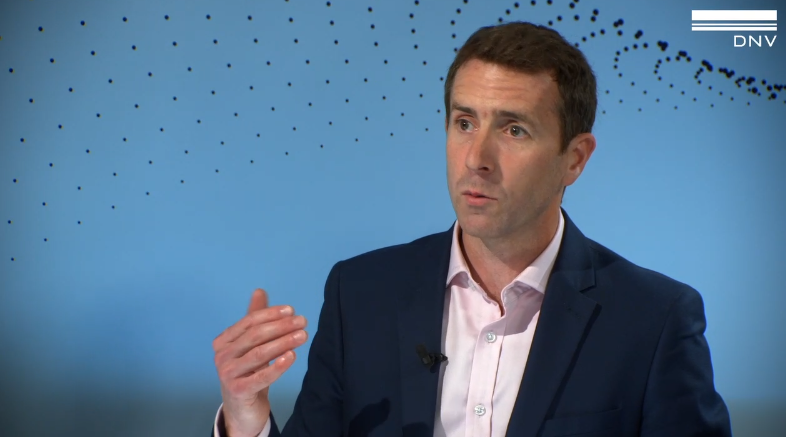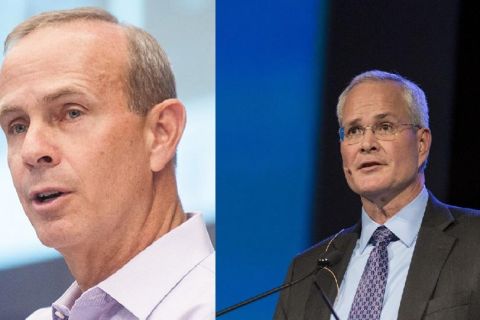As the world moves faster toward renewables, the energy industry faces a great deal of uncertainty in how to finance the transition while still generating revenue. However, the task is not as financially infeasible as many seem to think. In the webinar “Financing the Energy Transition” hosted by DNV, several guest speakers discussed what financial and policy provisions need to be made in the transition.
Jeremy Parkes, global business lead for electrical vehicles at DNV who authored the Financing the Energy Transition report, predicts “an equal mix of fossil and non-fossil sources of primary energy supply” by 2050, compared to 80% of the world’s energy supplied by fossil fuels and 20% non-fossil fuels in 2019.
“We forecast that the growth in energy demand starts to slow down and then plateaus off due to the continuous improvement in energy efficiency,” Parkes said. “That also means that there'll be a substantial reduction in the use of fossil fuels. However, they do remain about half of the energy mix assets at 2050, but we see for aspects such as electrical energy demand that will double over the period from today out to mid-century.”
According to the report, the world needs to move at a faster pace to align with the Paris Agreement targets. However, it also insists that the world is financially capable of accelerating the energy transition.
“I think in terms of really being able to afford an accelerated transition, then what we would say is that instead of having that reduction in the percentage of GDP that we spend on energy, instead of doing that, hold the amount of GDP that we spend a consistent over those three decades,” Parkes said. “And if we were to do that, then there could potentially be of the order of 60 trillion U.S. dollars available to spend on a faster transition.”
“If you truly were to spend that amount, that's more than enough to accelerate that transition and get us onto a path where we can achieve a 1.5 degree, future for the temperature rise compared to two pre-industrial temperatures,” he continued. “The question then becomes how do we orchestrate that massive redirection of capital in order to achieve that accelerated transition whilst maintaining reliable energy systems that are truly affordable to all?”

Industry perspective
Members of the energy industry have made it known in recent years their concerns about financing the energy transitions, as it sounds like a massive undertaking. According to Hilde Roed, senior vice president of climate and sustainability at Equinor, a lot of those concerns stem from the uncertainty surrounding how to invest capital as the industry continues to adapt.
“There is a need to change the way we invest very fast, and there's also a need for investments in climate adaptation. So all of this of course creates both challenges, but also industry opportunities,” Roed said. “And for us as a company and companies that go to that, that's oil and gas companies, we want to change and we think that we have a very central role to play in this transition because we have capital and they also have the technologies and people in space to drive some of these changes that are necessary.”
To keep up with the evolving energy environment, companies like Equinor are putting their investments toward renewable technologies and policies, such as carbon pricing, as opposed to traditional fossil fuel-reliant technologies. However, Roed said that the government should help ease the financial burden of transitioning.
“We've seen with renewables how important it is to get help from governments and how to get policy frameworks, actually into markets and get enough scale and that you can costs down and thereby also stopping competitive on the costs,” she said. “So we think that governments are needed to share risks, to provide incentives and also to ensure our unit provides currency and predictability and stability in the policy framework, so that businesses, and also our supply chains are willing to make the investments.”
Financial outlook
Seeing a number like $60 trillion can make the energy transition seem unattainable, but it may not be as out of reach as one would expect. Daniel Wong, global head of Macquarie Capital and chair of Macquarie’s Green Investment Group, pointed out that since the energy transition has been underway for decades now, a lot of the notable green technologies—primarily wind and solar—have become more cost-efficient as they’ve worked their way into the framework of the energy industry.
“With respect to clean power, wind and solar, I think it's pretty fair to say that it's cheap power now,” Wong said. “And in many respects it's cheaper than conventional sources of power. And it's just a case of taking the level of deployment and scaling up to levels that we haven't seen before.”
“I'm also optimistic because there are a number of ecosystems being built around this green energy and you've got electricity or electric vehicles and the electrification of everything,” he continued. “And the key constraint in that clearly was the price point for batteries, which has actually come down so much to facilitate the electrification of transport, which is already starting to accelerate, tipping points have already happened.”

Wong also insisted that global governments need to take a more hands-on leadership role when it comes to preparing the environment for these rapid evolutions in technology. Leadership must enforce regulations to allow companies to understand how to invest their money into environmentally friendly projects moving forward.
“I think the most important thing for government to do here is to set the price signals so that investing in these technologies will actually deliver a revenue line that can cover expenses, including the capital expenditure,” Wong said. “And then as that equation starts to make sense with some degree of government support, then plainly the technology curve should play in all of the cost of this capital expenditure to come down over time.”
Policy viewpoint
While each country will handle the financing transition differently, one common necessity is transparency between governments and companies so that companies know how to deliver clean energy. Nina Skorupska, CEO of the Association for Renewable Energy and Clean Technology, said that while governments have come forth with declarations of net-zero emission by 2050, they “need to see those ambitions translated into clear policies.”
“Nearly anything that impacts decarbonizing power, whether it's solar and wind approaches, or even the onshore activities in people's homes and transport, we need to make sure that the infrastructure and the regulations help support that in a timely fashion,” Skorupska said. “So instead of just looking at power and efficiency overall, they're actually aligning transport, buildings, infrastructure and combining holistically looking at how we can nudge these factors forward.”
Policymakers want to keep capital flows in mind when creating energy regulations, ensuring that the energy transition doesn’t inhibit operators’ ability to generate revenue. According to Sean Kidney, co-founder and CEO of the Climate Bonds Initiative, a simple solution is to reduce interest rates on investments.
“We give a discounted capital,” Kidney said. “I want to say to the Indian delegation to COP, stop the table as much as you like and ask for cash transfers, but at the end of the day, settle for really cheap capital. And that's what we can get to spot the political sclerosis of the rich countries of the world. If we can reduce the cost of capital, it's everything, it unleashes the floods.”
Recommended Reading
Air Products Sees $15B Hydrogen, Energy Transition Project Backlog
2024-02-07 - Pennsylvania-headquartered Air Products has eight hydrogen projects underway and is targeting an IRR of more than 10%.
NOV's AI, Edge Offerings Find Traction—Despite Crowded Field
2024-02-02 - NOV’s CEO Clay Williams is bullish on the company’s digital future, highlighting value-driven adoption of tech by customers.
Greenbacker Names New CFO, Adds Heads of Infrastructure, Capital Markets
2024-02-02 - Christopher Smith will serve as Greenbacker’s new CFO, and the power and renewable energy asset manager also added positions to head its infrastructure and capital markets efforts.
After Megamerger, Canadian Pacific Kansas City Rail Ends 2023 on High
2024-02-02 - After the historic merger of two railways in April, revenues reached CA$3.8B for fourth-quarter 2023.
Exxon, Chevron Tapping Permian for Output Growth in ‘24
2024-02-02 - Exxon Mobil and Chevron plan to tap West Texas and New Mexico for oil and gas production growth in 2024, the U.S. majors reported in their latest earnings.





